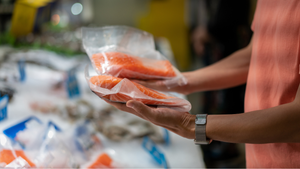Performance Foods Poised for PopularityPerformance Foods Poised for Popularity
With many consumers’ definition of health shifting, from descriptors such as low in calories or low in fat to descriptors such as all-natural and nutrient-rich, potatoes are on the rise on menus.
March 19, 2019

Long thought of as merely a tasty side dish, potatoes are much more than their mashed, fried or hashbrowned appearance lets on. For one thing, potatoes are a complex carbohydrate, which is the primary fuel for the brain and a key source of energy for muscles. In addition, potatoes with skin on are a good source of potassium. In fact, potatoes have more potassium than a medium-sized banana and more than any of the other 20 top-selling fruits and veggies. Additionally, a medium potato is naturally free from fat, cholesterol, sodium and gluten. Potatoes have long been an underrated source of fuel, but that’s about to change.
With many consumers’ definition of health shifting, from descriptors such as low in calories or low in fat to descriptors such as all-natural and nutrient-rich, potatoes are on the rise on menus.
What are “performance foods”?
When it comes to choosing healthful foods, 64% of consumers say they are eating more foods because of their specific nutritional benefits than they were two years ago, according to Technomic’s 2018 Healthy Eating report. The most sought-after nutrients on the list include protein (41% of consumers look for it), vitamin C (40%), fiber (40%), vitamin D (36%) and calcium (34%). Performance foods are, in essence, foods that fuel performance, athletic and otherwise. Most people don’t consider the potato a performance food and are surprised when they learn it is. Beyond carbohydrates and potassium, potatoes also contain other important nutrients, including fiber (7% of the daily value), vitamin B6 (10% of the DV), and vitamin C (30% of the DV). Also, as a key component of muscle, protein is an important nutrient for athletic performance. A medium-size potato has three grams of protein that contain all nine essential amino acids.
Other performance foods include options such as quinoa, berries, salmon, beans, legumes, pasta, cruciferous veggies, nuts, nut butters and chocolate milk.
How do these nutrients help athletes?
Potatoes are notably more energy-packed than any other popular vegetable, with 110 calories per 5.3-ounce portion. It’s critical for athletes and other people to take in enough calories to support the demands of their day-to-day lives as well as their athletic pursuits. Additionally, because they are a complex carb, potatoes are ideal for fueling exercise sessions, including prolonged endurance sessions. The potassium in potatoes and other performance foods acts as an important electrolyte, helping with nervous system, cardiovascular and muscle function.
Menuing performance foods
Potatoes as side dishes are a common menu item, but updating them to be even more enticing is easy—pair them with other natural performance foods such as kale or spinach. For instance, think garlic mashed potatoes with spinach. Infusing mashed potatoes with veggie purees or blends creates a host of new crave-worthy flavors, and even creates a visually appealing side dish. Add potatoes to a breakfast plate with roasted vegetables including carrots, onions and peppers for a supercharged hash-style meal. For foodies, potatoes paired with emerging and growing ingredients such as fennel (up 4% year-over-year in potato dishes, according to MenuMonitor), salsa verde ( 3%), pecorino cheese ( 2%) or swiss chard ( 2%) can be appealing. Update main dishes with potatoes, too. Swapping in potato noodles or spiralized potatoes for classic pasta gives diners a nutrient-dense and gluten-free choice for their favorite dishes while increasing the potassium, vitamin C, fiber and other nutrients they need to perform their best. After all, potatoes are naturally fat free, sodium free, and cholesterol free. It’s what’s paired with potato dishes that lend to their natural performance capibilities.
Potatoes can also be a great base in bowl meals—baked, mashed or roasted potatoes dressed up with fixings such as lean meats, additional veggies, legumes, sauces and other tasty toppings, potato bowls offer the energy diners need to get through a busy day or a demanding workout. Highlight potatoes’ healthfulness on menus to ensure diners are aware of their benefits, and watch orders stack up.
You May Also Like





